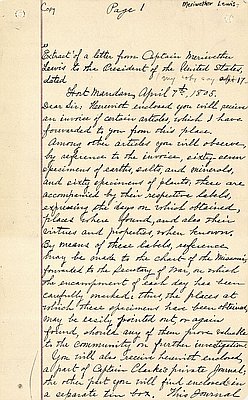This excerpt from the journal of Meriwether Lewis describes the Corps of Discovery’s encounter with the Walla Walla Indians and their headman Yelleppit. After crossing the Umatilla River—which Lewis calls the “Youmalolam”—on their return to the east, the “much fatigued” explorers stopped for a time to eat. While encamped they were met by Yelleppit and six other Indians. Lewis and Clark recognized the Walla Walla headman from the previous fall, when they had stopped briefly at his village across from the mouth of the Walla Walla River, giving him a small medal and promising to spend a few days with him the following spring.
Little is known about Yelleppit aside from what is contained in the journals of Lewis and Clark. The explorers first met him in October 1805, when they described him as “a bold handsom Indian, with a dignified countenance about 35 years of age, about 5 feet 8 inches high and well perpotiond.” It is unlikely that Yelleppit was his regular name; yalipt is a Sahaptin word that means “trading friend.” This was a formal social relationship among Plateau peoples, whose economy was based in large part on trading, gifting, and other forms of exchange.
Lewis noted that Yelleppit was “a man of much influence not only in his own nation but also among the neighbouring tribes and nations.” He was very interested in the American explorers, who he viewed as valuable potential trade partners. He convinced the newcomers to stay at his village for a couple of days, during which time the Walla Wallas entertained them with dancing and music. A nearby community of Yakamas also joined in the celebration.
Before the explorers took their leave of the Walla Wallas, whom Lewis described as a “friendly honest people,” Yelleppit presented Clark with a “very eligant white horse,” asking for a copper trade kettle in return. The captains had already given away all of the kettles they could spare, so Clark presented Yelleppit with his own sword instead, as well as some gun powder and a hundred musket balls. It would be another twelve years before the Walla Wallas would establish lasting trade relations with the newcomers, though. In 1818, the Northwest Company built a trading post called Fort Nez Perce—later known as Fort Walla Walla—at the mouth of the Walla Walla River.
Further Reading:
Ronda, James P. Lewis and Clark among the Indians. Norman, Okla., 1984.
Moulton, Gary, ed. The Journals of the Lewis & Clark Expedition. Vols. 5 and 7. Lincoln, Nebr., 1988-1991.
Written by Cain Allen, © Oregon Historical Society, 2004.



